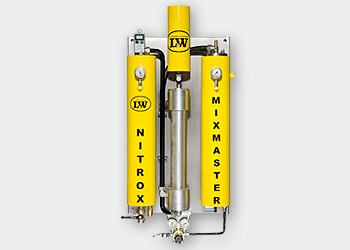Nitrox membrane systems are based around a special semi-permeable „filter“ called a membrane. The membrane is fed with very clean, low pressure air. The air is separated between oxygen and nitrogen within the membrane leaving a higher percentage of oxygen (> 28 - 40%) in the gas that exits the sides of the membrane, and a higher percentage of nitrogen (> 90 - 99%) exiting the top of the membrane. The capacity of the membrane is the amount of nitrox produced. This is then compressed in a suitable HP compressor, the quantity of nitrox must be higher than the delivery rate of the HP compressor due to some loss within the HP compressor.
The membrane therefore has a degree of waste (the nitrogen) so that the amount of air entering the membrane is considerably higher than the nitrox exiting the membrane. This air requirement is the most important factor when sizing either the high pressure storage or the low pressure compressor that feeds the membrane and increases drastically with an increase in oxygen percentage of the nitrox.
L&W membranes are available in two sizes S & L. The L membranes can also be mounted in parallel to produce even higher quantities of nitrox if required (> 800 litre/min).

